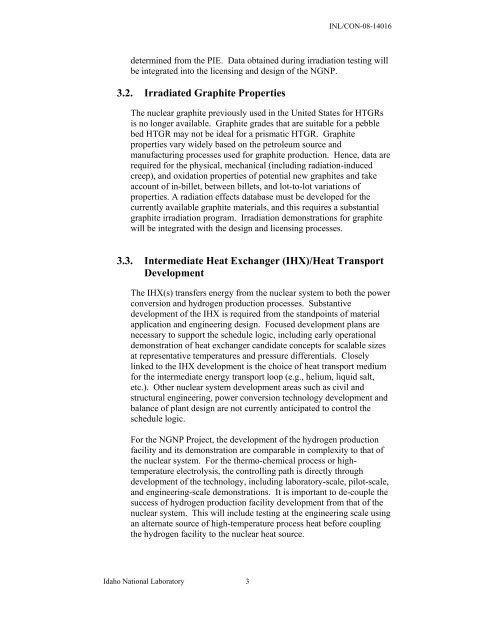Hydrogen Production from the Next Generation Nuclear Plant
Hydrogen Production from the Next Generation Nuclear Plant
Hydrogen Production from the Next Generation Nuclear Plant
You also want an ePaper? Increase the reach of your titles
YUMPU automatically turns print PDFs into web optimized ePapers that Google loves.
INL/CON-08-14016<br />
determined <strong>from</strong> <strong>the</strong> PIE. Data obtained during irradiation testing will<br />
be integrated into <strong>the</strong> licensing and design of <strong>the</strong> NGNP.<br />
3.2. Irradiated Graphite Properties<br />
The nuclear graphite previously used in <strong>the</strong> United States for HTGRs<br />
is no longer available. Graphite grades that are suitable for a pebble<br />
bed HTGR may not be ideal for a prismatic HTGR. Graphite<br />
properties vary widely based on <strong>the</strong> petroleum source and<br />
manufacturing processes used for graphite production. Hence, data are<br />
required for <strong>the</strong> physical, mechanical (including radiation-induced<br />
creep), and oxidation properties of potential new graphites and take<br />
account of in-billet, between billets, and lot-to-lot variations of<br />
properties. A radiation effects database must be developed for <strong>the</strong><br />
currently available graphite materials, and this requires a substantial<br />
graphite irradiation program. Irradiation demonstrations for graphite<br />
will be integrated with <strong>the</strong> design and licensing processes.<br />
3.3. Intermediate Heat Exchanger (IHX)/Heat Transport<br />
Development<br />
The IHX(s) transfers energy <strong>from</strong> <strong>the</strong> nuclear system to both <strong>the</strong> power<br />
conversion and hydrogen production processes. Substantive<br />
development of <strong>the</strong> IHX is required <strong>from</strong> <strong>the</strong> standpoints of material<br />
application and engineering design. Focused development plans are<br />
necessary to support <strong>the</strong> schedule logic, including early operational<br />
demonstration of heat exchanger candidate concepts for scalable sizes<br />
at representative temperatures and pressure differentials. Closely<br />
linked to <strong>the</strong> IHX development is <strong>the</strong> choice of heat transport medium<br />
for <strong>the</strong> intermediate energy transport loop (e.g., helium, liquid salt,<br />
etc.). O<strong>the</strong>r nuclear system development areas such as civil and<br />
structural engineering, power conversion technology development and<br />
balance of plant design are not currently anticipated to control <strong>the</strong><br />
schedule logic.<br />
For <strong>the</strong> NGNP Project, <strong>the</strong> development of <strong>the</strong> hydrogen production<br />
facility and its demonstration are comparable in complexity to that of<br />
<strong>the</strong> nuclear system. For <strong>the</strong> <strong>the</strong>rmo-chemical process or hightemperature<br />
electrolysis, <strong>the</strong> controlling path is directly through<br />
development of <strong>the</strong> technology, including laboratory-scale, pilot-scale,<br />
and engineering-scale demonstrations. It is important to de-couple <strong>the</strong><br />
success of hydrogen production facility development <strong>from</strong> that of <strong>the</strong><br />
nuclear system. This will include testing at <strong>the</strong> engineering scale using<br />
an alternate source of high-temperature process heat before coupling<br />
<strong>the</strong> hydrogen facility to <strong>the</strong> nuclear heat source.<br />
Idaho National Laboratory 3
















